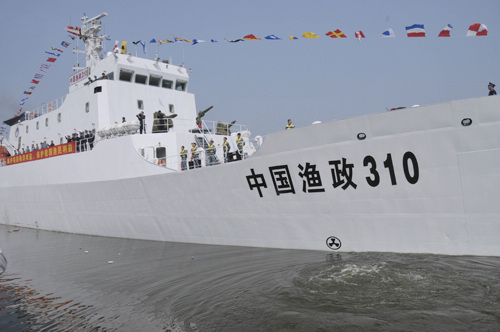|
 |
|
SAFEGUARDING FISHING WATERS: Yuzheng 310, China's most advanced fishery administration vessel, is sent to the Huangyan Island after the Sino-Philippine standoff broke out (LIANG GANGHUA) |

Relations between China and the Philippines have been tense since Chinese surveillance vessels intercepted a Philippine naval ship attempting to harass Chinese fishermen near the Huangyan Island, called Huangyan Dao in Chinese, in the South China Sea on April 10.
Following the incident, both countries sent more vessels to the area, leading to a persistent standoff. China's Foreign Ministry summoned a top diplomat of the Philippine Embassy to lodge complaints. While considering the incident the most severe standoff with China in the waters of the South China Sea in recent years, the Philippines relented shortly afterward. Philippine President Benigno Aquino III denied the possibility of a war between the two sides. Philippine Foreign Secretary Albert Del Rosario also stressed the importance of the Sino-Philippine friendship. At the same time, however, Manila declared it would bring the case to the International Court of Justice. These bewildering moves obscured the Philippines' real motives.
Over the past years, the Chinese Government has exercised forbearance on challenges from the Philippines. The Philippines illegally arrested Chinese fishermen and even shot and killed a fisherman near the Huangyan Island in the past. This time, however, Chinese surveillance vessels patrolling nearby defeated Philippine harassment and protected Chinese fishermen. Apparently, the Philippines did not expect China would make such a strong response to safeguard the sovereignty of its territories in the South China Sea.
China's policy on safeguarding its marine territories has been undergoing changes. Chinese surveillance vessels have become an important means for securing sovereignty and territorial integrity in the South China Sea, the East China Sea and other areas through regular patrols.
For a long time, the Chinese Government has given priority to stability in the South China Sea in a bid to maintain good neighborly relations with other countries in the region. More often than not, China keeps forbearance about violations of international laws and agreements by some countries, and hopes to mitigate tensions through economic cooperation with them. But China's restraint is regarded as "weakness." In their view, China won't take a strong stance on the issue. As a result, a weird situation where small countries bully a big country has appeared in the South China Sea.
Among all the disputing countries, the Philippines and Viet Nam are two rampant challengers. China's tolerance does have a limit. It should not be taken for granted that China will always tolerate provocation.
China believes the islands in the South China Sea have been Chinese territories since ancient times. For the Chinese Government and people, violating the historical reality means challenging China's sovereignty and territorial integrity. Due to the lack of maritime strength and attention, the Chinese Government failed to make a long-term strategy for the South China Sea following the founding of the People's Republic of China in 1949.
China now maintains a position in the Nansha Islands, called Nansha Qundao in Chinese, thanks to the UN Educational, Scientific and Cultural Organization (UNESCO). In 1987, UNESCO decided to establish a global ocean observing system, including observation stations of worldwide sea levels. China accepted the task of constructing the No. 74 station in the South China Sea, showing that the UN acknowledges China's sovereignty over the Nansha Islands.
Apart from historical records, international agreements following World War II also confirm China's sovereignty over the South China Sea islands. When World War II ended, the Chinese Government took over these islands from Japanese occupation. But since the 1970s, some Southeast Asian countries have stepped up their efforts to occupy the reefs and islands and explore natural resources, such as oil and gas, in the South China Sea.
These countries have recently preferred to use the 1982 UN Convention on the Law of the Sea as the main justification for their claims. The convention establishes a 200-nautical-mile exclusive economic zone for coastal states. In their argument, China has given up these territories since it signed the convention. This is, of course, not true. While abiding by the convention, China believes historical facts should also be respected. If the Philippine Government files a lawsuit in the International Court of Justice against China, chances of succeeding are slim given the solid historical evidence and facts in China's favor.
Territorial disputes in the South China Sea caused a military conflict between China and Viet Nam in the 1980s. Authorized by the UN in 1987, China carried out a scientific study in the South China Sea. As the Chinese started to build observation facilities on its own islands, Viet Nam sent vessels to disturb the work. The harassment increased, and consequently, an unexpected conflict broke out when Vietnamese soldiers attacked Chinese sailors on the Chigua Reef in March 1988. Although the Vietnamese stopped interfering with observation station construction, they quickened the invasion of other reefs in the South China Sea. To date, Viet Nam has occupied 29 islands in the Nansha Islands.
| 